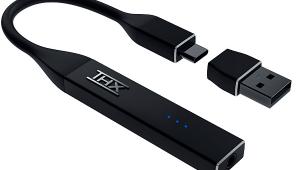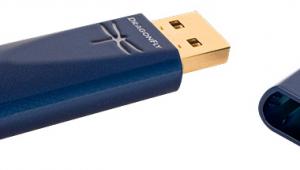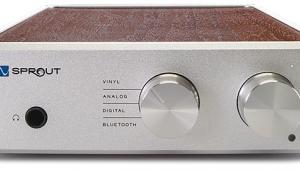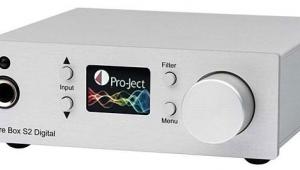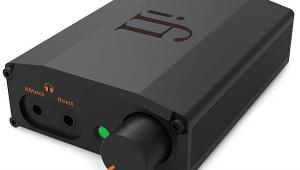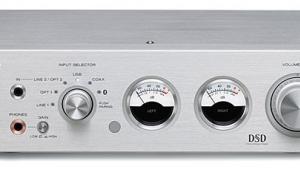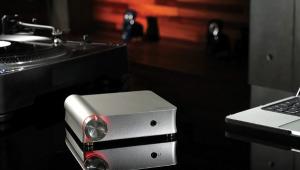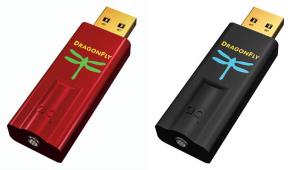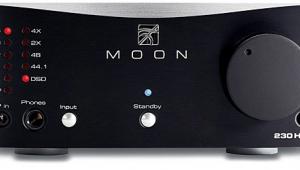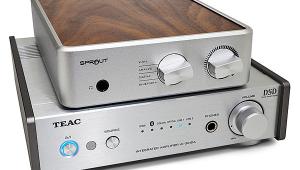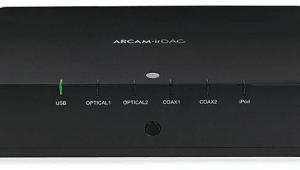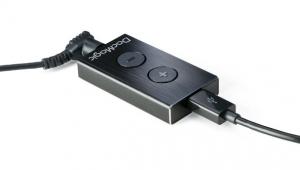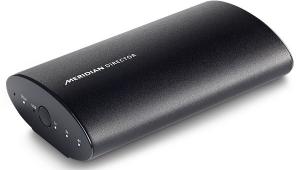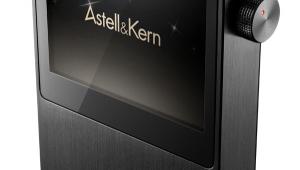Review: Audioquest DragonFly
I've had a DragonFly revolving in and out of my desktop setup ever since I first checked one out for S&V's 2012 Holiday Gift Guide, so I was already very familiar with its capabilities. To recap what I said in my intro, the DragonFly packs a 96/24-capable DAC (ESS Sabre) and headphone amp in a USB stick that plugs directly into your computer. While this plug-in scheme is convenient, it can also crowd out adjacent ports on your laptop. Indeed, during my comparison I found the external cable approach favored by both HRT and Meridian to be a more ergonomically sound solution. [Note: After this review posted, Audioquest reached out to inform me of its DragonTail, a $16.95 USB extender the company developed to solve the crowded computer ports issue. -A.G.]
Otherwise, Audioquest's design is as basic as can be: A dragonfly-shaped LED changes colors to indicate the resolution of the incoming signal, while a single 3.5mm jack serves both as a headphone output and a line-level connection to an outboard audio system. The DragonFly uses a computer-controlled analog volume adjustment to fix the output level of its headphone amp, thus bypassing any resolution-reducing digital volume attenuation on the computer end. (When the 3.5 mm jack is used as a line-level output, you set both your music playback software's volume slider and the computer's system volume to maximum and let the outboard gear handle level control.)
Performance
Audioquest's DAC might be up against some stiff new competition, but it still managed to hold up very well during comparative listening tests. Starting out with the Sennheiser cans, I cued up "Jubilee Street" from Nick Cave and the Bad Seeds' newest, Push the Sky Away. Cave's vocals had a full, upfront character, with plenty of detail and a good sense of spaciousness in the instrumental layers that build throughout the track. I did feel that strings sounded a bit more strident via the Dragonfly than on the other two DACs during the song's noisy climax, but just barely. Switching over to the Phiaton in-ear monitors, which tend to sound a bit soft in the treble, the DragonFly's pronounced clarity and detail actually made the two a perfect match.
Connected to my main speaker system, the DragonFly's crisp overall character was still in evidence. When I listened to "The House at Sea" from Amor de Dias, a Tropicalia-toned side project from British retro-rockers The Clientele, a guitar solo played on a nylon string acoustic sounded punchy and clear, and the same went for hi-hat and crash cymbal hits. I also liked the way the DragonFly pulled Hope Sandoval's laid-back vocals on Mazzy Star's "Flowers of December" forward in the mix. Compared with the Meridian Explorer, I ultimately found the DragonFly's sound a bit thin on a few tracks. Differences between it and the microStreamer, however, proved more elusive.
Listening to high-rez FLACs with the DragonFly, I found nothing to gripe about. When I played the Jimmy Cobb Quartet's "Every Time We Say Goodbye," an HDtracks.com download, there was a strong sense of air around the instruments, with plucked guitar strings and a lightly brushed snare drum conveying completely natural textures.
Bottom Line
Audioquest's USB stick DAC may the smallest of the three under consideration here, but its sound packs a big punch. It's also a versatile performer, mating well with everything from on-ear and in-ear headphones to systems incorporating full-range tower speakers. The newcomers here may have an edge when it comes to ergonomics/design, but after listening to the DragonFly anew, I'm still impressed.
- Log in or register to post comments
